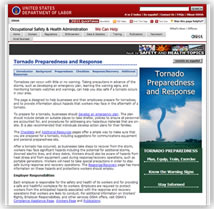Please note: As of January 20, 2021, information in some news releases may be out of date or not reflect current policies.
News Release
Offering safety and health assistance to tornado damaged communities

|
WASHINGTON, Ill. — U.S. Department of Labor's Blog, (Work in Progress), features a post by Barry Salerno, assistant area director for the Occupational Safety and Health Administration's Peoria office, providing information about the role of OSHA in disaster recovery.
Editor's Note: With proper attribution, we grant permission for cross-posting. Please find the post's text below:
Dealing with natural disasters and the devastating impact on people's personal life is always a difficult task, but when disaster strikes your own community, finding a way to help takes on a whole new meaning.
The rare November EF4 tornado that extensively damaged Washington Sunday, Nov. 17, struck close to home for the staff in the Peoria Area Office of the Occupational Safety and Health Administration. We all live within a few miles of the devastation zone, and our director lives in Washington, one of the hardest hit communities. Fortunately, none of the staff suffered serious damages but our neighbors did.
Less than 24 hours after the storm ripped through this rural community, I and compliance officer Diana Lopez from our staff were walking the streets, talking to residents and providing information on how to stay safe during recovery efforts. We also had compliance officers other staff, Edward Marshall and Jeb Stuart, visiting residents in other affected areas, such as Pekin, East Peoria and Coal City. The tornado packed winds of 190 mph and a path of destruction that stretched for more than 46 miles through Tazewell and Woodford counties, according to the weather service. The staff was there to provide help and assistance.
Tornadoes were also reported in the small town of Gifford near Rantoul, Metropolis in far southeast Illinois, and Frankfort and Manhattan in Will County. OSHA responders from the area offices in Calumet City, North Aurora and Fairview Heights responded to these areas and offered assistance as well.
What we have found are people sifting through debris piles looking for personal items and being exposing to various safety and health hazards. Some of the most pressing hazards are struck-by hazards from debris, unstable structures and puncture hazards from exposed nails and shards of wood and glass. We also found children and adults climbing and working on roofs on their homes without fall protection or training and entering basements with unstable structures above.
Our focus right now is on the residents of the community and helping them minimize their own risk of injury and illness as they work through the recovery of personal items and removal of debris. We are telling people to wear protective clothing such as gloves, and closed toed shoes, not to enter unstable structures and just trying to bring awareness to them of the hazardous they may encounter.
People are really receptive to the help. Most residents have never been involved in a disaster recovery operation and really aren't aware of many of the dangers present. They just want to salvage what they can of their lives.
 |
One of the biggest challenges is educating people about the role of OSHA in disaster recovery. Often times people believe OSHA is there in an enforcement role, but our role is to help protect workers and volunteers from potential hazards caused by the storm. We want to minimize further stress and grief to the residents that could occur if workers, volunteers or residents are injured in recovery efforts.
Response and recovery work in tornado-impacted areas presents safety and health hazards that should be properly identified, evaluated and controlled in a systematic manner. Some operations, such as utility restoration, cleaning up spills of hazardous materials, and search and rescue, should only be conducted by workers who have the proper training, equipment and experience.
As Washington moves into this phase of clean-up in the next few days, we will be working with contractors to ensure they are working safely. As power is restored, it will bring new concerns as well in ensuring residents and workers are operating safely.
The Regional Office safety and health manager Larken S. Akins is working with the local Incident Commander to offer OSHA's services assisting with safety and health concerns for workers and residents and with conducting risk assessments.
We are also providing fact sheets and quick cards, which provide access to online resources.
I believe this is a very important role for OSHA to be able to help the community in recovering and rebuilding safely. Specific hazards associated with working in the aftermath of tornados that we detailed in our safety sheets included:
- Hazardous driving conditions due to slippery and/or blocked roadways, slips and falls due to slippery walkways;
- Falling and flying objects, such as tree limbs and utility poles;
- Sharp objects including nails and broken glass;
- Electrical hazards from
- downed power lines or downed objects in contact with power lines and
- the use of portable generators that may be missing safety components or are not grounded properly;
- Falls from heights;
- Risk of entering unstable structures;
- Lack of communication services;
- Use of skid loaders and other mechanical equipment in areas with heavy pedestrian traffic and by inexperienced operators;
- Gas leaks and dangers posed by the restoration of utilities, such as unexpected energized lines; and
- Exhaustion from working extended shifts and dehydration.
